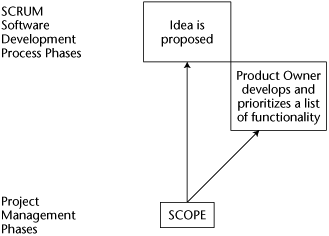The Scoping Phase of the Iterative SDPM Strategy for the SCRUM Model
Figure 18-2 illustrates the project management Scoping Phase integrated with the Idea and Functionality List Phases of the Iterative SDPM strategy of the SCRUM model. The resulting Iterative SDPM strategy for the SCRUM Scoping Phase is quite different than that of other Iterative SDPM Scoping Phases. The primary difference is in the role of the customer. In this model, called the “Product Owner,” the customer is the lead individual in defining requirements, functions, and features. The customer takes a more proactive role in the development life cycle. Before launching into SCRUM you should verify that the customer can fill this role. Many cannot, and the last thing you want to do is take them out of their comfort zone and place them in a threatening position. If you are fixed on using the SCRUM model, you may need to support the Product Owner in fulfilling their tasks.
Figure 18-2. The Project Management Scoping Phase integrated with the Idea and Functionality List Phases of the SCRUM model

In addition to preparing the Project Overview Statement, four other tasks are part of the SCRUM scoping phase. They are:
Idea creation
Gathering requirements
Defining the required functions
Prioritizing functions
These are each described in the following subsections.
Idea Creation
The Product Owner (customer) initiates the ...
Get Effective Software Project Management now with the O’Reilly learning platform.
O’Reilly members experience books, live events, courses curated by job role, and more from O’Reilly and nearly 200 top publishers.

